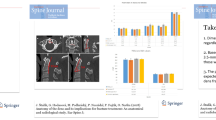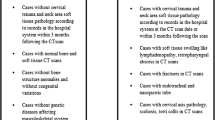Abstract
The attachment point of the transverse lig. of the atlas was investigated in a series of 234 human skeletons of different ages and 42 cadaver dissections. This attachment point was found to be a bony bump at the lateral mass of the atlas which we called the colliculus atlantis. These findings were confirmed by a retrospective study of more than 20.000 radiographs of the cervical spine. Furthermore, the study showed that the colliculus atlantis is developed by age 13 at the latest and that it is visible in the open-mouth view radiograph. The rare absence of the colliculus atlantis in the adult was found to be associated with lack of tension in the transverse lig. and thus at its attachment points due to dysfunction of the craniocervical joints. This dysfunction may be congenital (e.g. Morquio’s syndrome, Kniest’s syndrome) or acquired before age ten (e.g. trauma). In conclusion, the attachment point of the transverse lig. was found to be a product of normal function of the craniocervial junction and changes in the morphology and site of the colliculus atlantis in certain inflammatory processes (e.g. juvenile chronic polyarthritis, salmonellar spondylitis) or injuries (Jefferson’s fracture) allow an early diagnosis followed by an early adequate therapeutic procedure
Similar content being viewed by others
Author information
Authors and Affiliations
Rights and permissions
About this article
Cite this article
Weiglein, A.H., Schmidberger, H.R. The radio-anatomic importance of the colliculus atlantis. Surg Radiol Anat 20, 209–214 (1998). https://doi.org/10.1007/s00276-998-0209-9
Received:
Accepted:
Issue Date:
DOI: https://doi.org/10.1007/s00276-998-0209-9




